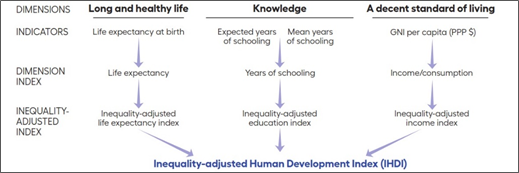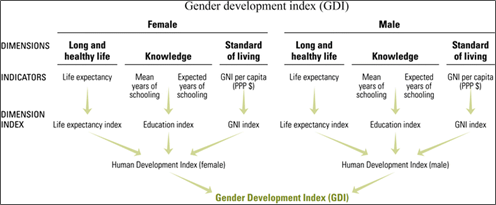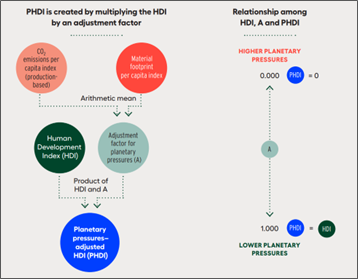1. Inequality-adjusted Human Development Index (IHDI)
-
- IHDI adjusts the Human Development Index (HDI) for inequality in each dimension of human development: a long and healthy life, a good education, and a decent standard of living.
- The IHDI value equals the HDI value when there is no inequality across people but falls below the HDI value as inequality rises. In this sense, the IHDI measures the level of human development when inequality is accounted for.

2. Gender Inequality Index (GII)
-
- The GII is brought out along with the Human Development Report by the United Nations Development Programme (UNDP).
- GII reflects gender-based disadvantage in three dimensions— reproductive health, empowerment and the labour market—for as many countries as data of reasonable quality allow.
- It shows the loss in potential human development due to inequality between female and male achievements in these dimensions.
- It ranges from 0, where women and men fare equally, to 1, where one gender fares as poorly as possible in all measured dimensions.

3. Gender Development Index (GDI)
-
- The Gender Development Index (GDI), published by the UN Development Programme (UNDP), measures gender gaps in human development achievements by accounting for disparities between women and men in 3 basic dimensions of human development using the same component indicators as in the Human Development Index (HDI).
- These key dimensions of human development are a long and healthy life, being knowledgeable, and a decent standard of living.
- The GDI is the ratio of the HDIs calculated separately for females and males using the same methodology as in the HDI. It is a direct measure of gender gap, showing the female HDI as a percentage of the male HDI.

4. Planetary Pressures-adjusted HDI (PHDI)
-
- PHDI is the level of human development adjusted by carbon dioxide emissions per person (production-based) and material footprint per capita to account for the excessive human pressure on the planet.
- PHDI discounts the HDI for pressures on the planet to reflect a concern for intergenerational inequality, similar to the Inequality-adjusted HDI adjustment which is motivated by a concern for intragenerational inequality.

Intra-generational equity: This refers to fairness and justice within a single generation. It’s about ensuring that all individuals within a generation have access to resources, opportunities, and benefits fairly, regardless of factors such as socioeconomic status, ethnicity, or gender. Intra-generational equity addresses issues like income inequality, access to healthcare, education, and basic needs within a society.
Intergenerational equity: It pertains to fairness and justice between different generations, ensuring that the needs and interests of future generations are considered and not compromised by the actions or decisions of current generations. It involves responsible justifiable use of resources, sustainable development practices, and environmental conservation to ensure that future generations inherit a world that is at least as viable as the one we inherited.
Spread the Word

